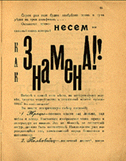

Trakat o sploshnom neprilichii (Treatise on Total Indecency)
(K. Zdanevich) Igor Terentyev
Tiflis, c. 1920. Edition: 300. Cover by Kiril Zdanevich.



Trakat o sploshnom neprilichii (Treatise on Total Indecency)
(K. Zdanevich) Igor Terentyev
Tiflis, c. 1920. Edition: 300. Cover by Kiril Zdanevich.
In the winter of 1917, avant-gardists Ilya and Kiril Zdanevich, Aleksander Kruchenykh, and Igor Terentyev came together in the city of Tiflis to establish the "University of 41=B0." As self-proclaimed advocates for the advancement of avant-garde poetry, the members of 41=B0 produced a number of non-traditional publications, the most theoretical of which is Trakat.. In this treatise, Terentyev argues that the members of 41=B0 are more courageous and visionary than most of the other futurist writers, and reinforces the argument that a word's meaning is actually derived from its sound.Though the typography in this work does not directly relate to the message or add further insight to the text, Trakat is highly regarded for its approach to typography as a true form of art, and is recognized to be one of the most radical works of its time. Experiments abound throughout the book: letters and words lay on their sides, Cyrillic and Latin typefaces mix and mingle within the same sentence, and parts of words are printed in capital letters to illustrate internal, or alternative, word meanings. Though certain devices, such as arranging words in a diagonal or "zigzag" manner, and placing one syllable perpendicular to the next had been employed previously by the Italian futurists, Terentyev's ironic and blasphemous use of elegant typefaces such as cursive and Church Slavic to proclaim slogans such as "Bloom, you daughter of a bitch!" are decidedly Russian.
(Howard Schickler)
Return to the Futurist page
Look at contemporary artists' typography influenced by the futurists
See how letterforms were used as illustration and pages designed as a totality in an Egyptian papyrus
See an Arabic illuminated manuscript
Look at a Hebrew illuminated manuscript
Look at Fluxus work which was influenced by the Futurist aesthetic
Look at other forms of writer and artist collaborations in the twentieth century
Photos thanks to Howard Schickler Fine Art, where you can find Russian books of this period.